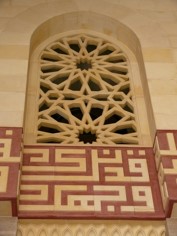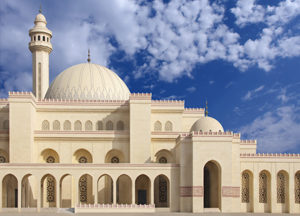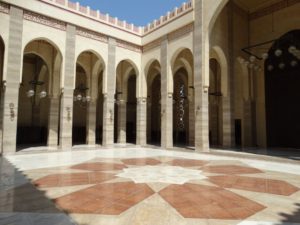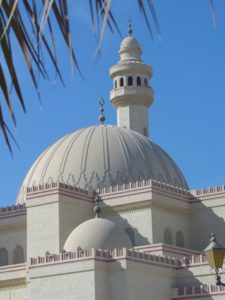Islamic Art in Al-Fateh Mosque
Typically Islamic art has focused on the depiction of patterns and Arabic calligraphy, rather than on figures, because it is feared by many Muslims that the depiction of the human form can lead to idolatry and thereby a sin against God..
Geometric Shapes and Repetitive Art (arabesque)
The eye cannot miss the geometric shapes and patterns at Al-Fateh Mosque. These appear everywhere: on the marble floor, on the carpets, on the walls, on the doors and on the windows. Though this kind of art is not part of the Islamic faith, yet the fact that art is a form of expression cannot be ignored. Common interpretations of this art include the following: The concept of God’s infinite power is expressed through geometry and designs with repeating themes which suggest infinity.


Calligraphy
Calligraphy for the Muslim is a visible expression of spiritual concepts. The book of Islam, the Qur’an, is in Arabic and it has played a vital role in the preservationof the Arabic language, and by extension, in the development of Arabic calligraphy. Verses from the Qur’an are an active source for Islamic calligraphy.
Kufic is the oldest calligraphic form of the various Arabic scripts and can be found adorning the walls of Al-Fateh Mosque. Its name is derived from the city of Kufa in Iraq although this script was known in Mesopotamia at least 100 years before the foundation of Kufa. It consists of straight lines and angles, often with elongated verticals and horizontals. It was in this script that the first copies of the Qur’an were written. It is still employed in Islamic countries though it has undergone a number of alterations over the years and also displays regional differences.
Islamic Architecture in Al-Fateh Mosque
The word mosque is the translation of the Arabic word masjid which is any clean place where one can perform prostration (sujood) to God. A building where people can prostrate together with others is therefore called a masjid.
Distinguishing motifs of Islamic architecture have always been ordered repetition and rhythmic, metric patterns. In this respect, fractal geometry has been a key utility, especially for mosques. Other significant features employed as motifs include columns, piers and arches. Arabic Calligraphy is used to enhance the interior of a building by providing quotations from the Qur’an.

You can see the following traditional elements at Al-Fateh Mosque:
- Mihrab
A mihrab is a niche in the wall of a mosque where the Imam (the prayer leader) stations himself to lead the congregation in prayers. The Mihrab is an acoustic device, a resonator for the voice, shaped to bounce the sound back and magnify it at the same time. Since this is where the Imam prays, the Mihrab therefore indicates the qibla, that is, the direction of the Kaaba (a prayer house built by Prophet Abraham and his son Ishmael in Mecca) and hence the direction that Muslims should face when praying. - Minbar (also pronounced mimbar)
Prophet Muhammad (peace and blessings of God be upon him) stood on a platform with three steps in order to preach. This platform developed into a minbar which is a pulpit in the mosque where a khatib (person who gives a speech) stands to deliver sermons (khutbah). Being raised above the ground allows the person to see all the worshippers in case of a large crowd. While minbars are usually more akin to pulpits in elevation and structures, they have a function and position more similar to that of a lectern: emphasizing contact with the audience.

Minaret
The minaret serves a dual function. It is both a landmark and place from which the call to prayer is broadcast. At the time of Prophet Muhammad the one who gave the call to prayer (Arabic muathin, sometimes also pronounced muazzin) used to give the call from the roof of a building. It was not until the 14th century that the minaret became a universal feature of mosques. The minaret is a tall, slender tower attached to a mosque. Each minaret has a balcony that the muathin uses to give his call. The height of the minaret, over a neighborhood has helped the sound to be transmitted. In most modern mosques, as in Al-Fateh Mosque, the athan (call to prayer) is no longer given in the minaret, but in the prayer hall via a microphone. A single minaret is the norm, but some mosques do have more than one minaret. Al-Fateh Mosque has two minarets, each rising to 70 meters (230 feet) above the ground level.
Sahn
A sahn in Islamic architecture is a courtyard. Originally, it was used for residential buildings, mainly houses and palaces, as a private internal garden; later on it was used for every building. The use of sahn in architecture continued until the mid-twentieth century when modernism in architecture began to affect the design of both houses and public buildings.
In many mosques there is a sahn, surrounded by an arcade from all sides. The sahn in the mosque is not a religious necessity; hence some mosques do not have a sahn. In a practical sense, these are used for natural ventilation and to bring the natural light into the building.


Dome
The dome has been a feature of Islamic architecture since at least the 12th century. The dome of a mosque is usually the most dominant feature, expressed by height, shape and volume. The dome of Al-Fateh Mosque is made of fiberglass. It is about 40 meters (132 feet) from ground level and 25 meters (82 feet) in diameter. There are twelve stained glass windows in the dome.In the past the high ceiling, domes, and large windows served as a control system that allowed natural ventilation as well as daylight. The role of domes in Islamic architecture has been considerable. Its usage spans centuries, first appearing in 691 CE with the construction of the Dome of the Rock Mosque in Jerusalem.
